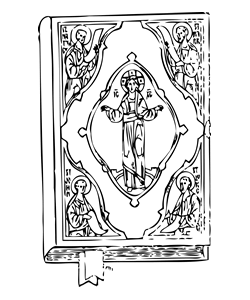|
|||
|---|---|---|---|
| This weekly bulletin insert complements the curriculum published by the Department of Christian Education of the Orthodox Church in America. This and many other Christian Education resources are available at http://dce.oca.org. | |||

What is known about the years between the Nativity and Theophany, the time during which Jesus was growing up and preparing for His three-year ministry? The second chapter of the Gospel of Luke gives us a bit of insight, in the description of the twelve-year-old Jesus answering the questions of the elders in the Temple. After this, He returns to Nazareth with Mary and Joseph, and is obedient to them (2: 46-51). Luke's words show that Jesus had the wisdom of His Father, and used it properly, to enlighten His people. The words also reveal His willingness to take on humanity completely, which included living in submission to two human parents. Beyond this, there is little if any information in the four Gospels about Jesus as a child or a young man growing into adulthood. But other books claim to tell us far more than the New Testament Gospels we read in church. These books describe a young Jesus showing his power by turning clay birds into real birds. When he doesn't like the way other children are acting, he curses them and turns them permanently into corpses, and then blinds their parents. Because the accounts in these books are so different from the early Church's experience of Jesus Christ, they were not accepted as part of the Gospel canon, meaning the group of books the Church regarded as truthful descriptions of God's plan and saving work. Documents that would become part of the New Testament had already been written just a few decades after Jesus' death and resurrection, some of them eyewitness accounts. These authentic descriptions formed the basis of the Church's teachings about the risen Lord. The great second-century saint Justin Martyr referred to the canonical Gospels as the "reminiscences" of the apostles. Saint Paul wrote in Ephesians 4: 4-6, "There is one body and one Spirit—just as you were called to one hope when you were called—one Lord, one faith, one baptism, one God and Father of us all." Paul's words show that the early Church was unified in its core beliefs about God, and therefore was quite able to distinguish those writings that did not reflect those beliefs. That is why books like those that depicted Jesus as a vengeful child did not make it into the canon of Scripture. Bible scholar Ben Witherington writes about this in his book "The Gospel Code: Novel Claims about Jesus, Mary Magdalene, and Da Vinci." Witherington's book is an excellent answer to fiction like "The Da Vinci Code" and other books that pretend to tell the "hidden truth" about the formation of the Bible. He explains how it really was formed, and happened, and enables the reader to determine which of the many writings about Jesus are fiction, and which are true Gospels. |
|||
